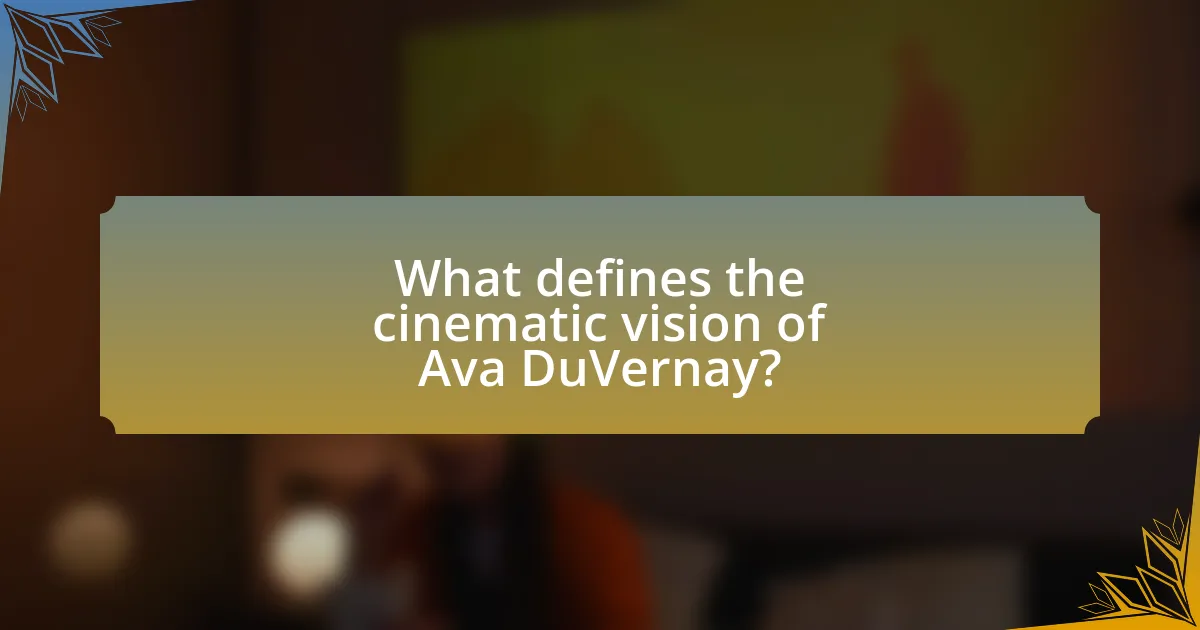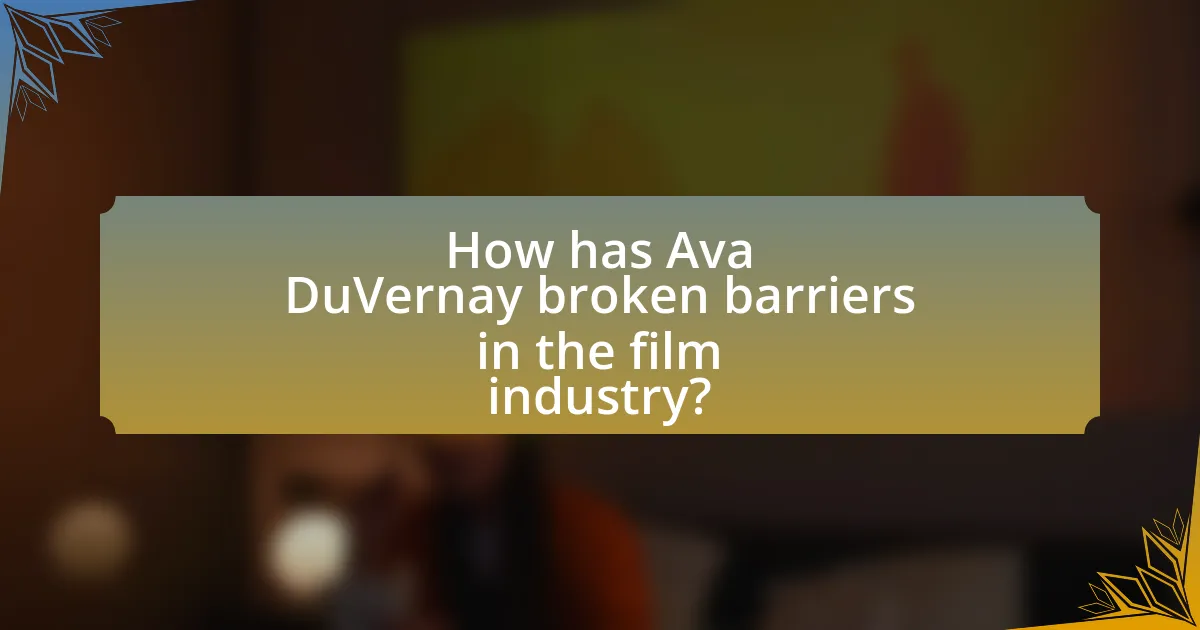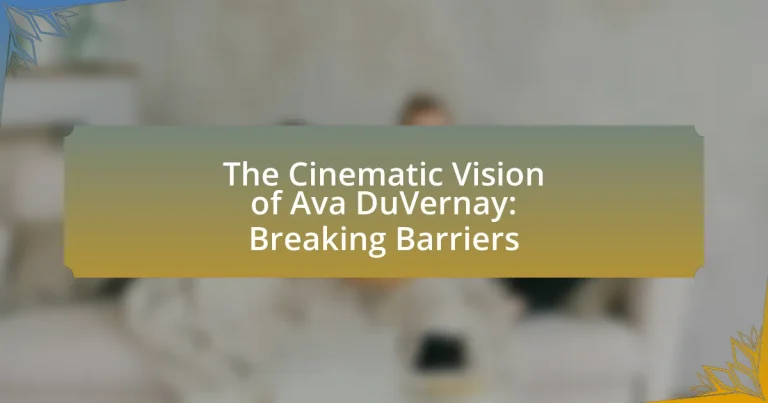Ava DuVernay is a prominent filmmaker known for her cinematic vision that emphasizes social justice, racial identity, and the experiences of marginalized communities. Her acclaimed works, including “Selma” and “13th,” showcase her commitment to authentic storytelling and representation, addressing systemic inequalities and historical injustices. DuVernay’s background as a Black woman from Los Angeles significantly influences her filmmaking style, while her innovative techniques and focus on diverse narratives have established her as a pioneering figure in contemporary cinema. The article explores her impact on the film industry, the challenges she has faced, and the initiatives she has launched to support diversity and representation in filmmaking.

What defines the cinematic vision of Ava DuVernay?
Ava DuVernay’s cinematic vision is defined by her commitment to storytelling that highlights social justice, racial identity, and the experiences of marginalized communities. This vision is evident in her acclaimed works such as “Selma,” which portrays the civil rights movement, and “13th,” a documentary that examines the intersection of race, justice, and mass incarceration in the United States. DuVernay’s use of rich visual aesthetics and character-driven narratives further reinforces her focus on empowering underrepresented voices in film, making her a pivotal figure in contemporary cinema.
How has Ava DuVernay’s background influenced her filmmaking style?
Ava DuVernay’s background as a Black woman from Los Angeles has significantly influenced her filmmaking style by shaping her focus on social justice themes and diverse narratives. Growing up in a multicultural environment, DuVernay developed a keen awareness of racial and gender disparities, which is evident in her works such as “Selma” and “13th.” These films not only highlight historical injustices but also emphasize the importance of representation in cinema. Her experiences in the film industry, including her role as a publicist before becoming a director, have further informed her approach to storytelling, prioritizing authentic voices and perspectives often overlooked in mainstream media.
What personal experiences shape her narratives?
Ava DuVernay’s narratives are shaped by her experiences as a Black woman navigating systemic racism and social injustice. Growing up in Los Angeles, she witnessed the impact of racial inequality, which informs her storytelling, particularly in films like “Selma” and “13th.” Her personal encounters with discrimination and her commitment to amplifying marginalized voices provide a foundation for her work, emphasizing themes of resilience and empowerment. These experiences are reflected in her cinematic choices, making her narratives both personal and universally relevant.
How does her cultural heritage reflect in her films?
Ava DuVernay’s cultural heritage is prominently reflected in her films through the exploration of African American experiences and social justice themes. Her works, such as “Selma” and “13th,” highlight historical injustices and the ongoing struggle for civil rights, showcasing her commitment to representing marginalized voices. DuVernay often incorporates elements of her own background, including the significance of community and resilience, which resonate throughout her narratives. For instance, “When They See Us” portrays the wrongful conviction of the Central Park Five, emphasizing systemic racism and its impact on families and communities, thus reinforcing her cultural perspective.
What themes are prevalent in DuVernay’s work?
Ava DuVernay’s work prominently features themes of racial injustice, social inequality, and the empowerment of marginalized voices. Her films, such as “Selma,” explore the civil rights movement, highlighting systemic oppression and the struggle for equality. Additionally, “13th” delves into the intersection of race and the criminal justice system, providing a critical examination of mass incarceration in the United States. DuVernay’s storytelling often emphasizes the importance of representation and the need for diverse narratives in mainstream media, as seen in her series “Queen Sugar,” which focuses on the complexities of African American life. These themes are consistently woven throughout her body of work, reinforcing her commitment to social justice and advocacy through cinema.
How does she address social justice in her films?
Ava DuVernay addresses social justice in her films by highlighting systemic inequalities and amplifying marginalized voices. In her acclaimed film “13th,” she explores the intersection of race, justice, and mass incarceration in the United States, providing historical context and statistical evidence to illustrate how policies have disproportionately affected African Americans. Additionally, in “Selma,” DuVernay portrays the civil rights movement, focusing on the struggle for voting rights, thereby emphasizing the importance of activism and community organizing in achieving social change. Through these narratives, DuVernay not only raises awareness but also encourages dialogue around pressing social issues.
What role does representation play in her storytelling?
Representation plays a crucial role in Ava DuVernay’s storytelling by ensuring diverse voices and experiences are authentically depicted. Her films, such as “Selma” and “13th,” highlight the complexities of race, gender, and social justice, providing a platform for underrepresented communities. This commitment to representation not only enriches the narrative but also fosters empathy and understanding among audiences, as evidenced by the critical acclaim and cultural impact of her work, which has sparked conversations about systemic inequality and the importance of inclusive storytelling.
What techniques does DuVernay use to convey her vision?
Ava DuVernay employs a variety of techniques to convey her vision, including powerful storytelling, visual symbolism, and a focus on marginalized voices. Her storytelling often integrates historical context with personal narratives, as seen in “Selma,” where she highlights the civil rights movement through the lens of Martin Luther King Jr.’s leadership. Visual symbolism is prevalent in her work; for instance, in “13th,” she uses archival footage and striking imagery to illustrate systemic racism in the United States. Additionally, DuVernay prioritizes the representation of underrepresented communities, ensuring that diverse perspectives are central to her narratives, which is evident in her series “Queen Sugar,” where she collaborates with a predominantly female directing team. These techniques collectively enhance her ability to communicate complex social issues and inspire audiences.
How does she utilize cinematography to enhance her narratives?
Ava DuVernay utilizes cinematography to enhance her narratives by employing striking visual compositions and purposeful camera movements that evoke emotional responses. For instance, in “Selma,” she uses close-ups to capture the intensity of characters’ emotions during pivotal moments, thereby deepening audience engagement with the historical context. Additionally, her collaboration with cinematographer Bradford Young results in a rich color palette and dynamic lighting that reflect the themes of struggle and resilience, reinforcing the narrative’s emotional weight. This intentional use of visual storytelling techniques not only elevates the narrative but also invites viewers to connect more profoundly with the characters and their journeys.
What innovative storytelling methods does she employ?
Ava DuVernay employs innovative storytelling methods such as non-linear narratives and multi-perspective storytelling. These techniques allow her to explore complex themes and characters in depth, as seen in her film “Selma,” which interweaves historical events with personal stories to create a rich tapestry of the civil rights movement. Additionally, DuVernay utilizes visual symbolism and powerful imagery to enhance emotional resonance, exemplified in “13th,” where she combines archival footage with contemporary interviews to highlight systemic racism in the U.S. justice system.

How has Ava DuVernay broken barriers in the film industry?
Ava DuVernay has broken barriers in the film industry by becoming the first African American woman to direct a film with a budget exceeding $100 million, specifically with “A Wrinkle in Time.” This achievement highlights her role in challenging the industry’s historical lack of representation for women and people of color in high-budget filmmaking. Additionally, DuVernay’s work on projects like “Selma” and the documentary “13th” has garnered critical acclaim and sparked important conversations about race and justice, further establishing her as a pioneering voice in cinema. Her commitment to diversity is also evident in her initiatives, such as the ARRAY Alliance, which focuses on promoting films by women and people of color, thereby reshaping the landscape of the film industry.
What challenges has she faced as a filmmaker?
Ava DuVernay has faced significant challenges as a filmmaker, including systemic racism and gender bias within the film industry. These obstacles have manifested in limited access to funding and distribution opportunities for her projects, as well as difficulties in gaining recognition for her work compared to her male counterparts. For instance, DuVernay’s film “Selma” faced hurdles in securing financing, which is a common issue for many filmmakers of color. Additionally, she has spoken about the lack of representation in decision-making roles in Hollywood, which further complicates the landscape for diverse voices in filmmaking.
How has she navigated the male-dominated industry?
Ava DuVernay has navigated the male-dominated film industry by leveraging her unique storytelling perspective and advocating for diversity. She has established herself as a prominent director and producer, creating critically acclaimed works such as “Selma” and “13th,” which highlight social justice issues. DuVernay founded ARRAY, a distribution company focused on amplifying the voices of women and people of color in film, further demonstrating her commitment to inclusivity. Her success is evidenced by her becoming the first African American woman to direct a film with a budget over $100 million, showcasing her ability to break through industry barriers.
What obstacles has she overcome in her career?
Ava DuVernay has overcome significant obstacles in her career, including racial and gender biases in the film industry. As a woman of color, she faced challenges in securing funding and distribution for her projects, which is evidenced by the fact that only 4% of directors of the top 100 grossing films in 2018 were women of color. Additionally, DuVernay navigated a lack of representation in leadership roles within Hollywood, which has historically limited opportunities for diverse voices. Her success in directing critically acclaimed films like “Selma” and “A Wrinkle in Time” demonstrates her ability to break through these barriers and advocate for greater inclusivity in cinema.
In what ways has she paved the way for other filmmakers?
Ava DuVernay has paved the way for other filmmakers by championing diverse storytelling and advocating for underrepresented voices in the film industry. Her work, including the critically acclaimed film “Selma,” not only highlights significant historical events but also emphasizes the importance of representation, inspiring a new generation of filmmakers to tell their own stories. DuVernay’s establishment of ARRAY, a distribution company focused on films by people of color and women, further demonstrates her commitment to creating opportunities for marginalized filmmakers, thereby reshaping the landscape of cinema.
How does her success inspire emerging filmmakers of color?
Ava DuVernay’s success inspires emerging filmmakers of color by demonstrating that diverse narratives can achieve critical and commercial success in the film industry. Her films, such as “Selma” and “13th,” have not only garnered awards but also sparked important conversations about race and justice, proving that stories from underrepresented communities resonate with audiences. This visibility encourages aspiring filmmakers of color to pursue their unique stories, knowing that their perspectives are valuable and can lead to impactful cinema. DuVernay’s establishment of initiatives like ARRAY, which supports and promotes films by women and people of color, further solidifies her role as a mentor and advocate, providing resources and platforms for emerging talent.
What initiatives has she launched to support diversity in film?
Ava DuVernay has launched several initiatives to support diversity in film, including the establishment of the ARRAY Alliance, which focuses on amplifying the voices of women and people of color in the film industry. ARRAY has provided resources, mentorship, and distribution opportunities for underrepresented filmmakers, significantly impacting the landscape of independent cinema. Additionally, DuVernay’s work on projects like “Selma” and “When They See Us” highlights diverse narratives and has garnered critical acclaim, further proving her commitment to inclusivity in storytelling.
What impact has DuVernay had on the representation of women in film?
Ava DuVernay has significantly impacted the representation of women in film by prioritizing diverse female narratives and creating opportunities for women filmmakers. Her films, such as “Selma” and “A Wrinkle in Time,” showcase strong female characters and highlight women’s experiences, contributing to a broader understanding of gender representation in cinema. DuVernay’s commitment to inclusivity is evident in her initiatives, like the ARRAY Alliance, which supports women and people of color in the film industry, thereby increasing visibility and access for underrepresented groups. This approach has led to a measurable increase in the number of women in key creative roles within the industry, as evidenced by studies showing that films directed by women tend to feature more female characters and stories.
How does she portray female characters in her films?
Ava DuVernay portrays female characters in her films as complex, multifaceted individuals who often confront societal challenges and personal struggles. In works like “Selma” and “A Wrinkle in Time,” she emphasizes their strength, resilience, and agency, showcasing women in leadership roles and pivotal positions within the narrative. For instance, in “Selma,” the character of Coretta Scott King is depicted not just as a supportive spouse but as a powerful figure in her own right, actively participating in the civil rights movement. This portrayal aligns with DuVernay’s commitment to highlighting the contributions of women, particularly women of color, in history and society, thereby challenging traditional gender roles and stereotypes in cinema.
What contributions has she made to women’s storytelling in cinema?
Ava DuVernay has significantly advanced women’s storytelling in cinema by prioritizing diverse narratives and amplifying the voices of women of color. She directed the groundbreaking film “Selma,” which not only highlighted the civil rights movement but also showcased the contributions of women like Coretta Scott King. Additionally, her work on the documentary “13th” brought attention to the intersection of race, gender, and mass incarceration, emphasizing the stories of women affected by systemic injustice. DuVernay also created the television series “Queen Sugar,” which features a predominantly female directing team, thereby fostering opportunities for women filmmakers. Her initiatives, such as the ARRAY Alliance, focus on distributing films by women and people of color, further solidifying her commitment to enhancing women’s representation in the film industry.
What are the key films that exemplify Ava DuVernay’s vision?
Ava DuVernay’s key films that exemplify her vision include “Selma,” “13th,” and “A Wrinkle in Time.” “Selma” portrays the civil rights movement, focusing on Martin Luther King Jr.’s efforts to secure voting rights, showcasing DuVernay’s commitment to historical accuracy and social justice. “13th” is a documentary that explores the intersection of race, justice, and mass incarceration in the United States, highlighting systemic racism and its implications. “A Wrinkle in Time,” while a fantasy film, emphasizes themes of empowerment and diversity, reflecting her vision of inclusivity in storytelling. These films collectively demonstrate DuVernay’s focus on social issues, representation, and the power of narrative to inspire change.
What is the significance of “Selma” in her filmography?
“Selma” is significant in Ava DuVernay’s filmography as it marks her emergence as a prominent filmmaker capable of tackling complex historical narratives. The film, released in 2014, chronicles the 1965 Selma to Montgomery voting rights marches led by Martin Luther King Jr., showcasing DuVernay’s ability to blend personal stories with broader social issues. It received critical acclaim, earning an Academy Award nomination for Best Picture and highlighting DuVernay’s skill in addressing themes of race, justice, and activism, which are central to her body of work. This film solidified her position as a leading voice in contemporary cinema, paving the way for future projects that continue to explore marginalized narratives.
How does “Selma” reflect her approach to historical narratives?
“Selma” reflects Ava DuVernay’s approach to historical narratives by emphasizing the complexity of the civil rights movement through a character-driven lens. DuVernay focuses on the personal struggles and motivations of key figures, such as Martin Luther King Jr., showcasing their humanity and the moral dilemmas they faced. This approach is evident in the film’s portrayal of the Selma to Montgomery marches, where the narrative intertwines personal stories with historical events, illustrating the broader social context. By highlighting the emotional and ethical dimensions of activism, DuVernay challenges traditional historical narratives that often simplify or overlook the individual experiences within larger movements.
What impact did “Selma” have on public discourse regarding civil rights?
“Selma” significantly impacted public discourse regarding civil rights by reigniting national conversations about racial inequality and voting rights. The film highlighted the historical events of the 1965 Selma to Montgomery marches, emphasizing the struggle for African American voting rights and the systemic oppression faced by Black citizens. Its release coincided with contemporary movements like Black Lives Matter, drawing parallels between past and present injustices. The film’s portrayal of key figures, such as Martin Luther King Jr., and its emotional storytelling galvanized audiences, prompting discussions in media, academia, and public forums about the ongoing relevance of civil rights issues. This renewed focus contributed to increased activism and awareness surrounding racial discrimination and voting access in the United States.
How does “13th” address systemic racism and mass incarceration?
“13th” addresses systemic racism and mass incarceration by illustrating how the 13th Amendment, which abolished slavery, contains a loophole that allows for involuntary servitude as punishment for crime. This documentary highlights the historical context of racial discrimination in the United States, showing how policies and laws have perpetuated a cycle of incarceration predominantly affecting African Americans. For instance, it cites that while African Americans make up approximately 13% of the U.S. population, they represent nearly 40% of the incarcerated population, demonstrating the disproportionate impact of the criminal justice system on Black communities. The film connects the dots between historical oppression, such as Jim Crow laws, and contemporary issues like the War on Drugs, emphasizing how systemic racism has been embedded in legal frameworks, leading to mass incarceration as a modern form of racial control.
What techniques does DuVernay use to present complex social issues in “13th”?
Ava DuVernay employs a combination of archival footage, expert interviews, and narrative storytelling to present complex social issues in “13th.” The use of archival footage provides historical context, illustrating the systemic racism and mass incarceration in the United States. Expert interviews with scholars and activists lend credibility and depth to the analysis, while narrative storytelling weaves personal accounts and statistics together, making the issues relatable and urgent. This multifaceted approach effectively engages the audience and fosters a deeper understanding of the intricate social dynamics at play.
How has “13th” influenced conversations about criminal justice reform?
“13th” has significantly influenced conversations about criminal justice reform by highlighting the historical and systemic racism embedded within the U.S. prison system. The documentary presents a compelling argument that the 13th Amendment, which abolished slavery, contains a loophole that allows for involuntary servitude as punishment for crime, thereby perpetuating a cycle of racial oppression. This connection has sparked widespread discussions among activists, policymakers, and the public, leading to increased awareness of mass incarceration’s impact on communities of color. The film’s release coincided with a growing movement advocating for reforms such as the decriminalization of certain offenses and the reevaluation of sentencing laws, demonstrating its role in shaping contemporary dialogues around justice reform.
What lessons can filmmakers learn from Ava DuVernay’s approach?
Filmmakers can learn the importance of authentic storytelling and representation from Ava DuVernay’s approach. DuVernay emphasizes the need to tell diverse stories that reflect the experiences of marginalized communities, as seen in her works like “Selma” and “13th,” which highlight historical and social issues affecting African Americans. Additionally, her commitment to inclusivity in casting and crew selection demonstrates the value of creating opportunities for underrepresented voices in the industry. This approach not only enriches the narrative landscape but also resonates with audiences, as evidenced by the critical acclaim and box office success of her films.
How can filmmakers effectively address social issues in their work?
Filmmakers can effectively address social issues in their work by incorporating authentic narratives that reflect the lived experiences of marginalized communities. For instance, Ava DuVernay’s film “13th” explores the intersection of race, justice, and mass incarceration in the United States, using historical context and personal stories to highlight systemic inequalities. This approach not only raises awareness but also fosters empathy among audiences, as evidenced by the film’s critical acclaim and its impact on public discourse surrounding criminal justice reform. By prioritizing diverse voices and perspectives, filmmakers can create powerful, thought-provoking content that drives social change.
What best practices can be derived from her storytelling techniques?
Ava DuVernay’s storytelling techniques emphasize authenticity, character depth, and social relevance, which serve as best practices for effective storytelling. Authenticity is achieved through her commitment to representing diverse voices and experiences, as seen in her films like “Selma,” which portrays historical events with emotional truth. Character depth is highlighted by her focus on complex, multidimensional characters, allowing audiences to connect on a personal level, exemplified in “When They See Us,” where real-life stories are told with nuance. Social relevance is underscored by her ability to tackle pressing societal issues, making her narratives not only engaging but also thought-provoking, as demonstrated in “13th,” which explores systemic racism in the U.S. These practices collectively enhance the impact of storytelling by fostering empathy and encouraging critical dialogue.


